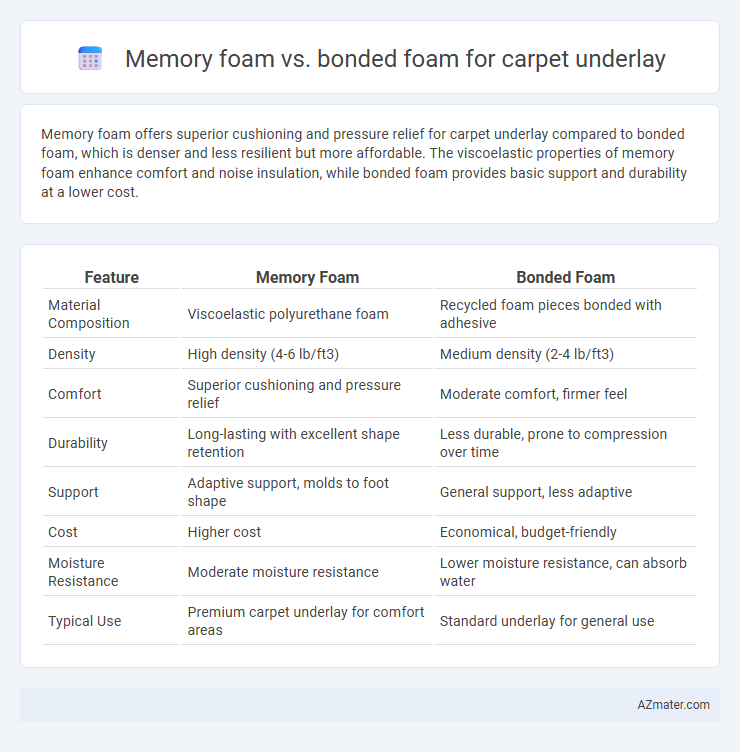Memory foam offers superior cushioning and pressure relief for carpet underlay compared to bonded foam, which is denser and less resilient but more affordable. The viscoelastic properties of memory foam enhance comfort and noise insulation, while bonded foam provides basic support and durability at a lower cost.
Table of Comparison
| Feature | Memory Foam | Bonded Foam |
|---|---|---|
| Material Composition | Viscoelastic polyurethane foam | Recycled foam pieces bonded with adhesive |
| Density | High density (4-6 lb/ft3) | Medium density (2-4 lb/ft3) |
| Comfort | Superior cushioning and pressure relief | Moderate comfort, firmer feel |
| Durability | Long-lasting with excellent shape retention | Less durable, prone to compression over time |
| Support | Adaptive support, molds to foot shape | General support, less adaptive |
| Cost | Higher cost | Economical, budget-friendly |
| Moisture Resistance | Moderate moisture resistance | Lower moisture resistance, can absorb water |
| Typical Use | Premium carpet underlay for comfort areas | Standard underlay for general use |
Introduction to Carpet Underlay Materials
Memory foam offers superior cushioning and pressure relief, making it an excellent choice for carpet underlay where comfort and durability are priorities. Bonded foam, composed of recycled foam scraps compressed together, provides firm support and cost-effective insulation but generally lacks the resilience and softness of memory foam. Selecting between memory foam and bonded foam underlay depends on factors such as desired comfort level, durability requirements, and budget constraints.
What is Memory Foam Underlay?
Memory foam underlay is a high-density polyurethane foam known for its exceptional comfort and pressure-relieving properties, often used beneath carpets to enhance cushioning and support. Unlike bonded foam, which is made from shredded foam pieces compressed together, memory foam contours to the weight and shape of the foot, providing superior sound insulation and durability. Its ability to retain shape and offer consistent comfort makes memory foam underlay ideal for high-traffic areas and improving overall carpet longevity.
What is Bonded Foam Underlay?
Bonded foam underlay is made by recycling shredded foam scraps bonded together with adhesive to create a dense, durable layer beneath carpets. This material offers excellent support and resilience, enhancing carpet longevity and providing superior insulation properties. Compared to memory foam, bonded foam is firmer, more cost-effective, and highly resistant to compression, making it ideal for high-traffic areas.
Comfort and Cushioning Comparison
Memory foam underlay offers superior contouring and pressure relief, adapting closely to foot shape for enhanced comfort and cushioning in carpet flooring. Bonded foam, created from recycled foam scraps compressed together, provides a denser and firmer base but lacks the same level of softness and shock absorption as memory foam. The higher resilience and slower recovery rate of memory foam result in a plush, supportive feel, while bonded foam delivers durability and cost-effectiveness with moderate cushioning performance.
Durability and Longevity
Memory foam carpet underlay offers superior durability due to its high-density structure, which maintains resilience and cushioning over time. Bonded foam, while cost-effective, tends to compress and degrade faster, resulting in reduced longevity and less effective support for carpets. Choosing memory foam enhances carpet lifespan by preventing premature wear and maintaining consistent floor comfort.
Impact on Carpet Lifespan
Memory foam underlay provides superior cushioning and resilience, reducing carpet wear by absorbing foot traffic impact and preventing premature fiber damage. Bonded foam, while more affordable, tends to compress over time, offering less support and accelerating carpet flattening and deterioration. Selecting memory foam underlay can significantly extend carpet lifespan by maintaining structural integrity and enhancing comfort underfoot.
Sound and Thermal Insulation Properties
Memory foam offers superior sound insulation by effectively absorbing impact noise and vibrations, making it ideal for multi-story buildings. Bonded foam provides moderate thermal insulation due to its dense, compressed structure that reduces heat transfer but is less effective at noise reduction. Choosing memory foam enhances both acoustic comfort and thermal efficiency under carpets, whereas bonded foam prioritizes affordability with decent insulation characteristics.
Installation and Maintenance Differences
Memory foam carpet underlay requires precise installation to ensure full support and prevent indentations due to its softer structure, often necessitating a professional fit for optimal performance. Bonded foam is more rigid and dense, making it easier to cut and fit during installation, and it tends to maintain its shape better over time, reducing maintenance needs. Maintenance for memory foam involves regular inspections to address compression and potential moisture trapping, whereas bonded foam offers enhanced durability with less frequent upkeep and better resistance to wear and tear.
Cost Analysis: Memory Foam vs Bonded Foam
Memory foam carpet underlay generally costs more than bonded foam due to its superior comfort and durability, with prices ranging from $2 to $4 per square foot compared to bonded foam's $1 to $2 per square foot. While memory foam offers better cushioning and support, bonded foam presents a more budget-friendly option ideal for high-traffic areas or short-term use. Considering long-term value, memory foam underlay may reduce wear on carpets and improve insulation, potentially offsetting the initial price difference.
Which Carpet Underlay is Best for Your Home?
Memory foam carpet underlay offers superior comfort and excellent pressure relief, making it ideal for high-traffic living areas where cushioning is essential. Bonded foam underlay, made from recycled foam scraps, provides durable support and enhanced insulation, which benefits energy efficiency and noise reduction in any home. Selecting the best carpet underlay depends on prioritizing softness and resilience, with memory foam excelling in comfort and bonded foam standing out for its eco-friendly durability and thermal properties.

Infographic: Memory foam vs Bonded foam for Carpet underlay
 azmater.com
azmater.com